Experimental Study of Cement Alkali-Resistant Glass Fiber (C-ARGF) Grouting Material
Abstract
:1. Introduction
2. Performance Test of Cement Alkali-Resistant Glass Fiber (C-ARGF) Grout Material
2.1. Test Materials and Equipment
2.2. Test Scheme
2.2.1. Slurry Mix Ratio and Experimental Group Design
Mix Ratio Design
Design of Experimental Group
2.2.2. Test Method
3. Results and Discussions
3.1. Experimental Results of CS
3.2. Experimental Results of TS
3.3. Experimental Results of FS
3.4. Experimental Results of IP
4. Engineering Applications
4.1. Overview of Qiyueshan Tunnel Project
4.2. Grouting Scheme Design
4.3. Grouting Treatment Effect and Analysis
5. Conclusions
Author Contributions
Funding
Conflicts of Interest
Nomenclature
| Cem-FIL60 | Cem-FIL®60 is a high cluster alkali-resistant glass staple fiber. |
| HD | Anti-Crak®HD (high dispersion) is an engineered AR glass chopped strand designed for mixing in concrete and all hydraulic mortars. |
| ARGF | Alkali-resistant glass fiber |
| C-ARGF | Cement alkali-resistant glass fiber |
| CS | Compressive strength |
| TS | Tensile strength |
| FS | Flexural strength |
| IP | Impervious performance |
| PH | Penetration height. |
| ECSR | Ratio of 3 d to 28 d CS for each experimental group, the early strength ratio of CS, which is abbreviated as ECSR. |
| ETSR | Ratio of 3 d to 28 d TS for each experimental group, the early strength ratio of TS, which is abbreviated as ETSR. |
| EFSR | Ratio of 3 d to 28 d FS for each experimental group, the early strength ratio of FS, which is abbreviated as EFSR. |
| EPR | Ratio of penetration height to specimen height (specimen height is 150 mm) at the curing time of 3 d. This ratio is called the early permeant ratio, which is abbreviated as EPR. |
References
- He, Z.L.; Li, Q.F.; Wang, J.W.; Yin, N.; Jiang, S.; Kang, M.Q. Effect of silane treatment on the mechanical properties of polyurethane water glass grouting materials. Construct. Build. Mater. 2016, 116, 110–120. [Google Scholar] [CrossRef]
- Faramarzi, L.; Rasti, A.; Abtahi, S.M. An experimental study of the effect of cement and chemical grouting on the improvement of the mechanical and hydraulic properties of alluvial formations. Construct. Build. Mater. 2016, 126, 32–43. [Google Scholar] [CrossRef]
- Duan, H.F.; Jiang, Z.Q.; Zhu, S.Y.; Yao, P.; Sun, Q. New composite grouting materials: Modified urea-formaldehyde resin with cement. Construct. Build. Mater. 2012, 22, 195–200. [Google Scholar] [CrossRef]
- Pan, D.J.; Zhang, N.; Xie, Z.Z.; Feng, X.W.; Kong, Y. Laboratory testing of silica sol grout in coal measure mudstones. Materials 2016, 9, 940. [Google Scholar] [CrossRef] [Green Version]
- Wang, Y.L.; Yu, J.; Wang, J.J.; Guan, X.M. Effects of aluminum sulfate and quicklime/fluorgypsum ratio on the properties of calcium sulfoaluminate (CSA) cement-based double liquid grouting materials. Materials 2019, 12, 1222. [Google Scholar] [CrossRef] [Green Version]
- Kim, D.; Jung, S.; Cha, K. Evaluation of the performance of grouting materials for saturated riprap. Materials 2013, 6, 5713–5725. [Google Scholar] [CrossRef] [Green Version]
- Sha, F.; Li, S.C.; Liu, R.T.; Zhang, Q.S.; Li, Z.F.; Liu, H.J. Experimental study and application of high efficiency grouting material in water-rich sand layer. Chin. J. Rock Mech. Eng. 2019, 38, 1420–1433. [Google Scholar]
- Chen, W.W.; Liu, J.; Gong, S.Y.; Yang, G.; Wang, D.Y.; Lin, G.C. Researches on the durability of the SH-(C+F+CaO) slurry applied to reinforce the cracks in earthen sites. Chin. J. Rock Mech. Eng. 2016, 35, 4310–4317. [Google Scholar]
- Zhang, J.K.; Wang, N.; Fan, M.; Ren, X.R.; Li, Z.X.; Zhao, L.Y. Experimental study on age properties of fissure grouting material composed of calcined ginger nuts and earthen site soil. Chin. J. Rock Mech. Eng. 2018, 37, 220–229. [Google Scholar]
- Zhang, C.; Yang, J.S.; Xie, Y.P.; Gong, F.H.; Liang, X.; Lei, J.S.; Su, B.Z. Experiment and application for grouting materials for karst under conditions of underground water flow before shield tunneling. Chin. J. Rock Mech. Eng. 2018, 37, 2120–2130. [Google Scholar]
- Zhang, C.; Yang, J.S.; Ye, X.T.; Zhang, Y.; Zhang, Z.B.; Su, B.Z. Experiment and application research on stability performance of filling grouting slurry. Chin. J. Rock Mech. Eng. 2018, 37, 3604–3612. [Google Scholar]
- Park, K.; Kim, D. Analysis of homogel uniaxial compression strength on bio grouting material. Materials 2016, 9, 244. [Google Scholar] [CrossRef] [PubMed] [Green Version]
- Ortega, J.M.; Esteban, M.D.; Rodríguez, R.R.; Pastor, J.L.; Ibanco, F.J.; Sánchez, I.; Climent, M.A. Long-term behaviour of fly ash and slag cement grouts for micropiles exposed to a sulphate aggressive medium. Materials 2017, 10, 598. [Google Scholar] [CrossRef] [PubMed]
- Ortega, J.M.; Esteban, M.D.; Sánchez, I.; Climent, M.A. Performance of sustainable fly ash and slag cement mortars exposed to simulated and real in situ Mediterranean conditions along 90 warm season days. Materials 2017, 10, 1254. [Google Scholar] [CrossRef] [Green Version]
- Nowoświat, A.; Gołaszewski, J. Influence of the variability of calcareous fly ash properties on rheological properties of fresh mortar with its addition. Materials 2019, 12, 1942. [Google Scholar] [CrossRef] [Green Version]
- Wei, X.; Ming, F.; Li, D.; Chen, L.; Liu, Y. Influence of water content on mechanical strength and microstructure of alkali-activated fly ash/GGBFS mortars cured at cold and polar regions. Materials 2020, 13, 138. [Google Scholar] [CrossRef] [Green Version]
- Perez-Garcia, F.; Parron-Rubio, M.E.; Garcia-Manrique, J.M.; Rubio-Cintas, M.D. Study of the suitability of different types of slag and its influence on the quality of green grouts obtained by partial replacement of cement. Materials 2019, 12, 1166. [Google Scholar] [CrossRef] [Green Version]
- Lee, J.; Kim, G.; Kim, Y.; Mun, K.; Nam, J. Engineering properties and optimal conditions of cementless grouting materials. Materials 2019, 12, 3059. [Google Scholar] [CrossRef] [Green Version]
- Liu, Q.; Chen, W.Z.; Yuan, J.Q.; Zhang, Q.Y.; Rong, C.; Wang, S.Q.; Zhao, L.T. Experimental study on grouting reinforcement of karst filled clay. Chin. J. Rock Mech. Eng. 2019, 38, 3179–3188. [Google Scholar]
- Nishimura, T.; Shinonaga, Y.; Nagaishi, C.; Imataki, R.; Takemura, M.; Kagami, K.; Abe, Y.; Harada, K.; Arita, K. Effects of powdery cellulose nanofiber addition on the properties of glass ionomer cement. Materials 2019, 12, 3077. [Google Scholar] [CrossRef] [Green Version]
- Wang, Q.B.; Zhu, Q.K.; Shao, T.S.; Yu, X.G.; Xu, S.Y.; Zhang, J.J.; Kong, Q.L. The rheological test and application research of glass fiber cement slurry based on plugging mechanism of dynamic water grouting. Constr. Build. Mater. 2018, 189, 119–130. [Google Scholar]
- Wang, P.; Jiang, L.S.; Zheng, P.Q.; Qin, G.P.; Zhang, C. Inducing mode analysis of rock burst in fault-affected zone with a hard-thick stratum occurrence. Environ. Earth Sci. 2019, 78, 467. [Google Scholar] [CrossRef]
- Jiang, L.S.; Wang, P.; Zheng, P.Q.; Luan, H.J.; Zhang, C. Influence of different advancing directions on mining effect caused by a fault. Adv. Civil Eng. 2019, 7306850. [Google Scholar] [CrossRef] [Green Version]
- Wang, P.; Jia, H.J.; Zheng, P.Q. Sensitivity analysis of bursting liability for different coal-rock combinations based on their inhomogeneous characteristics. Geomater. Nat. Hazards Risk 2020, 11, 149–159. [Google Scholar] [CrossRef] [Green Version]
- Tian, C.L.; Yang, X.L.; Sun, H.T.; Liu, Y.B.; Hu, Q.T. Experimental study on the overburden movement and stress evolution in multi-seam mining with residual pillars. Energy Sci. Eng. 2019, 7, 3095–3110. [Google Scholar] [CrossRef] [Green Version]
- Tian, C.L.; Liu, Y.B.; Yang, X.L.; Hu, Q.T.; Wang, B.; Yang, H.M. Development characteristics and field detection of overburden fracture zone in multiseam mining: A case study. Energy Sci. Eng. 2019, 00, 1–14. [Google Scholar] [CrossRef]
- Zhu, Z.D.; Zhang, C.; Meng, S.S.; Shi, S.S.; Tao, S.Z.; Zhu, D. A statistical damage constitutive model based on the Weibull distribution for alkali-resistant glass fiber-reinforced concrete. Materials 2019, 12, 1908. [Google Scholar] [CrossRef] [Green Version]
- Zhang, C.; Zhu, Z.D.; Zhu, S.; He, Z.; Zhu, D.; Liu, J.; Meng, S. Nonlinear creep damage constitutive model of concrete based on fractional calculus theory. Materials 2019, 12, 1505. [Google Scholar] [CrossRef] [Green Version]
- Liu, X.F.; Wang, J.G.; Huang, K.; Li, F.Y. Experimental study on dynamic water grouting of modified water-soluble polyurethane. KSCE J. Civil Eng. 2019, 23, 3897–3906. [Google Scholar] [CrossRef]
- Park, S.S.; Hou, Y.L. Tensile strength characteristics of cement paste mixed with fibers. J. Korean Geotech. Soc. 2015, 31, 5–16. [Google Scholar] [CrossRef] [Green Version]
- Zhang, C.; Liang, J.W.; Zhang, J.; Zhang, J.S.; Zhang, G.J.; Ye, X.T. Mechanism of Bingham fluid permeation and diffusion based on pulse injection. Rock Soil Mech. 2018, 39, 2741–2746. [Google Scholar]
- JGJ/T. 221-2010. Technical Specification for Application of Fiber Reinforced Concrete; Ministry of Housing and Urban-Rural Development: Beijing, China, 2011. [Google Scholar]
- GB/T. 50081-2002. Standard for Test Methods of Concrete Physical and Mechanical Properties; The Ministry of Construction and the State Administration of Time Management: Beijing, China, 2019. [Google Scholar]
- JTG. E30-2005. Test Methods of Cement and Concrete for Highway Engineering; Ministry of Communications: Beijing, China, 2005. [Google Scholar]
- ASTM. C1018-98. Standard Test Method for Flexural Toughness and First Crack Strength of Fiber-Reinforced Concrete: Using Beam with Third-Point Loading; American Society of Testing and Materials: West Conshohocken, PA, USA, 1998. [Google Scholar]
- JCI-S-001-2003. Method of Test for Fracture Energy of Concrete by Use of Notched Beam; Japan Concrete Institute: Tokyo, Japan, 2003. [Google Scholar]
- CECS 13. Standard Test Methods for Fiber Reinforced Concrete; China Engineering Construction Association: Beijing, China, 2009. [Google Scholar]
- DLT 5148-2012. Technical Specification for Cement Grouting Construction of Hydraulic Structures; National Energy Administration: Beijing, China, 2012. [Google Scholar]
- DL/T 5150-2017. Test Code for Hydraulic Concrete; National Energy Administration: Beijing, China, 2017. [Google Scholar]
- JTJ 270-98. Testing Code of Concrete for Port and Waterwog Engineering; Ministry of Communications: Beijing, China, 1998. [Google Scholar]


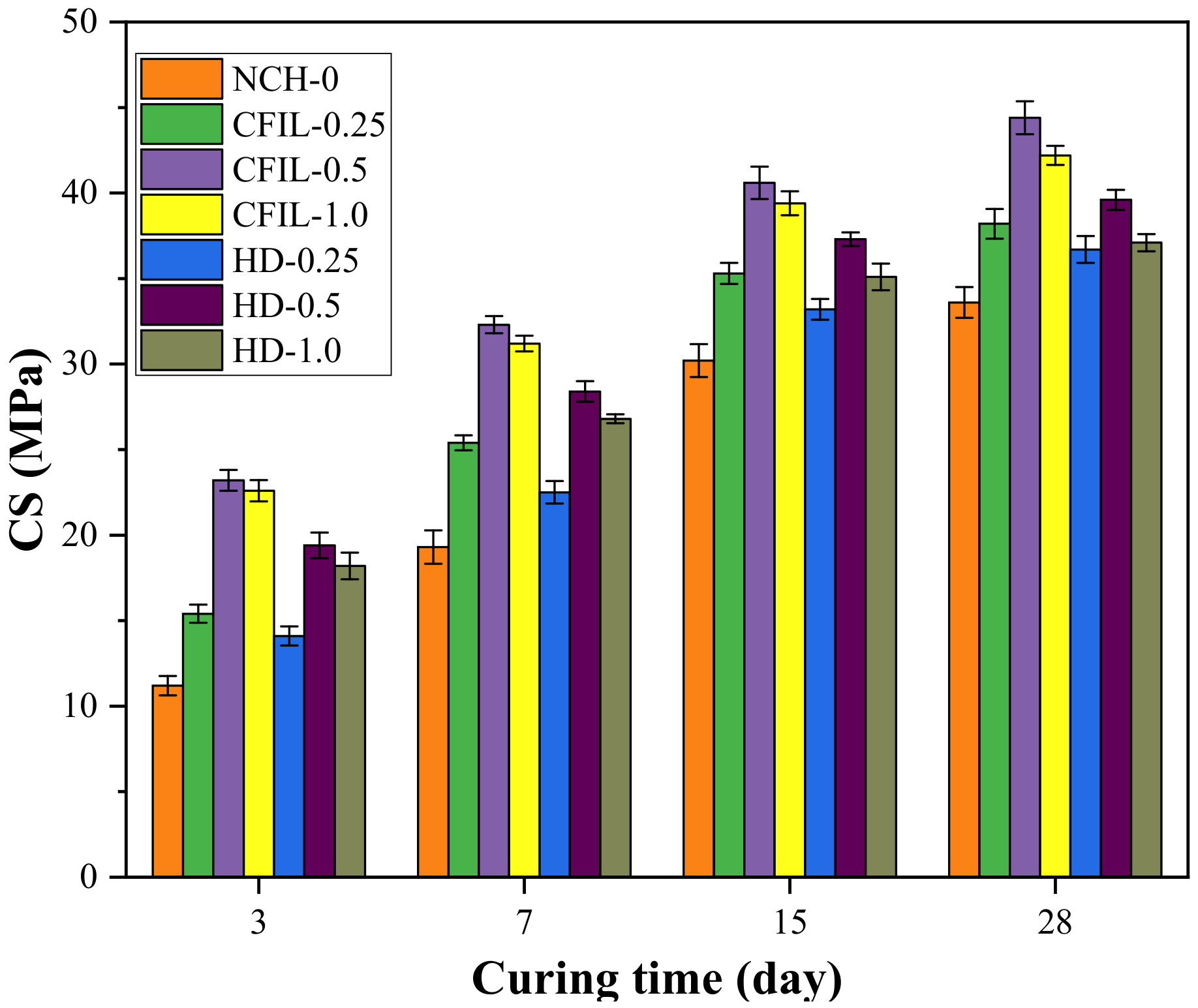

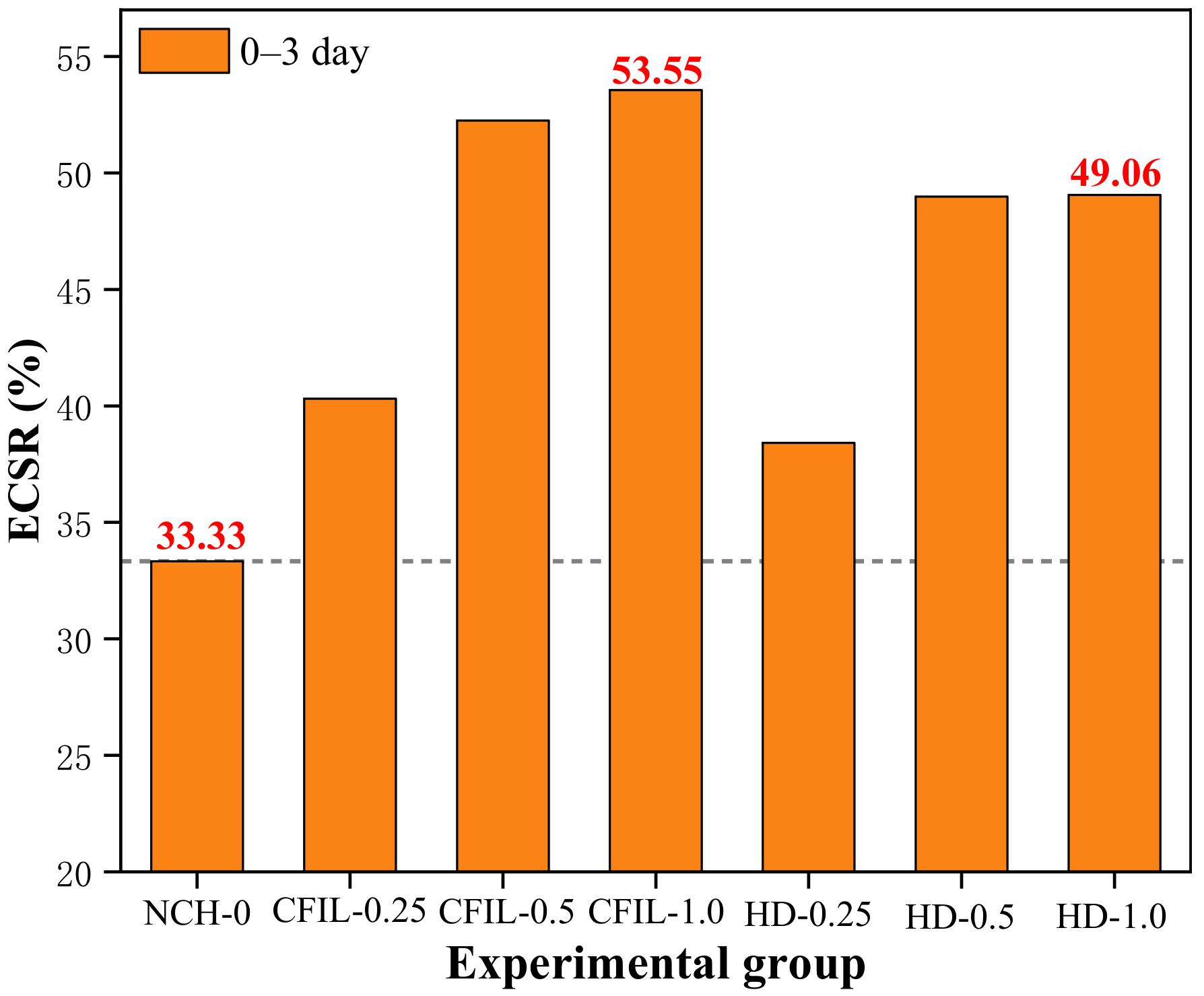


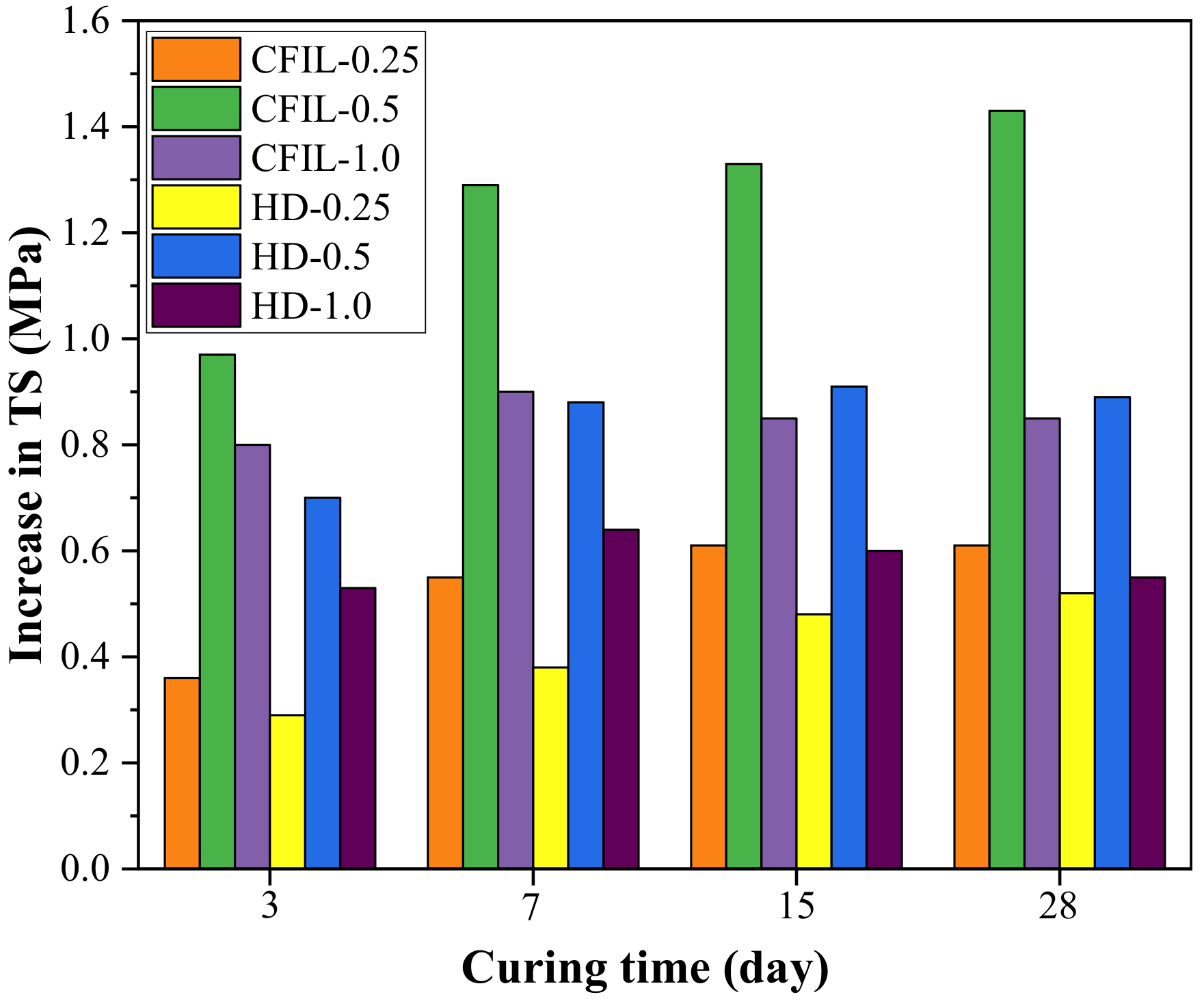
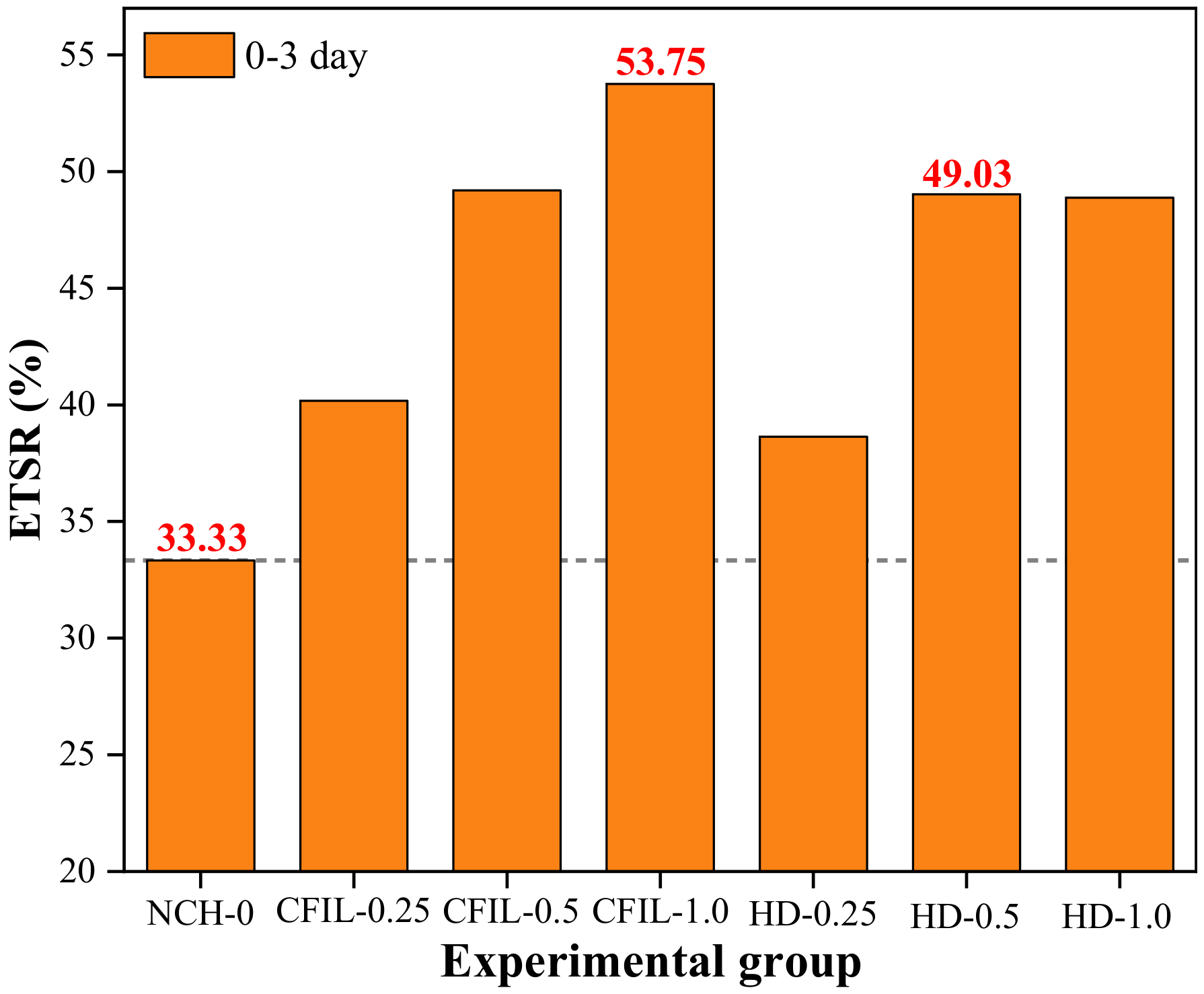





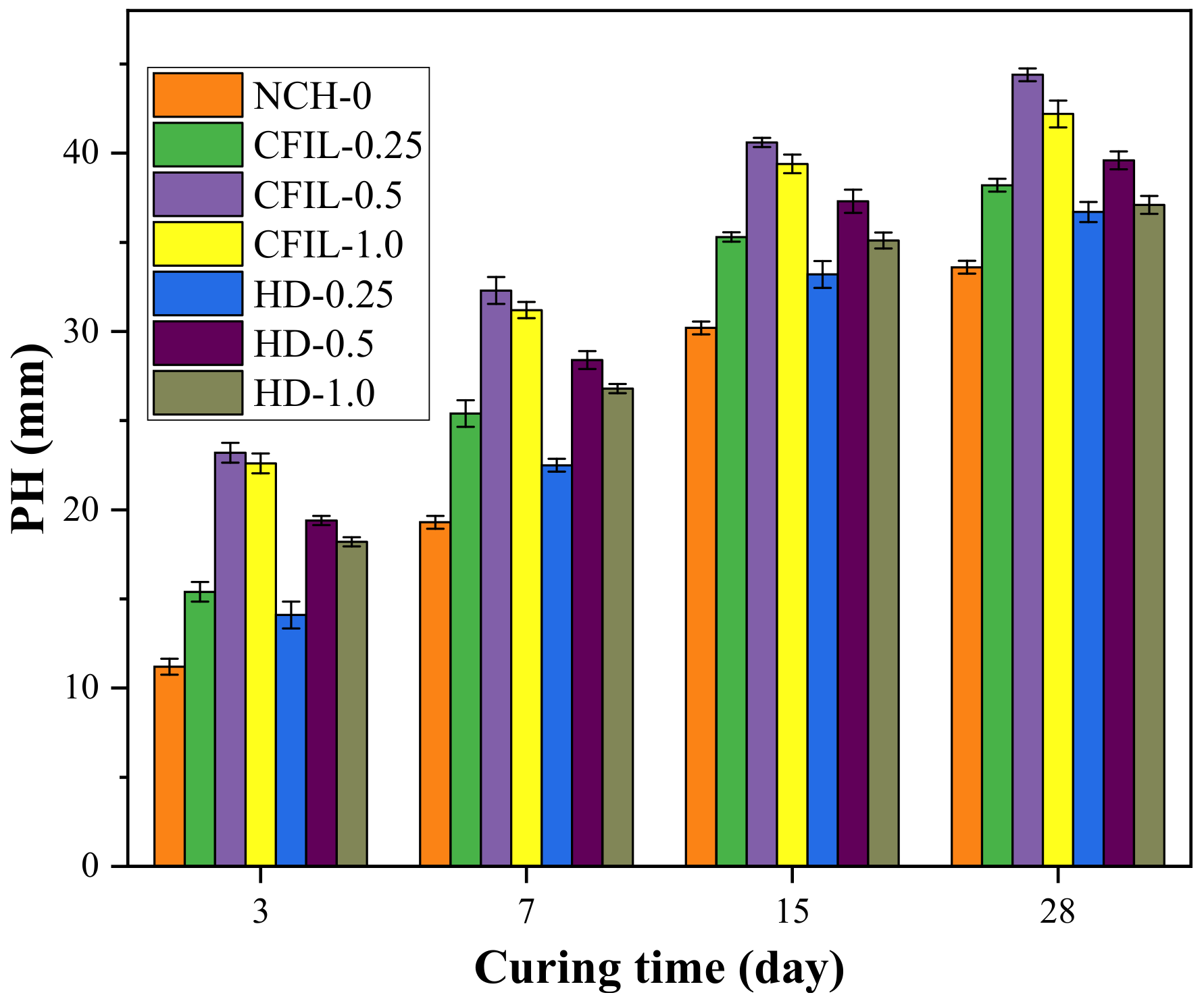



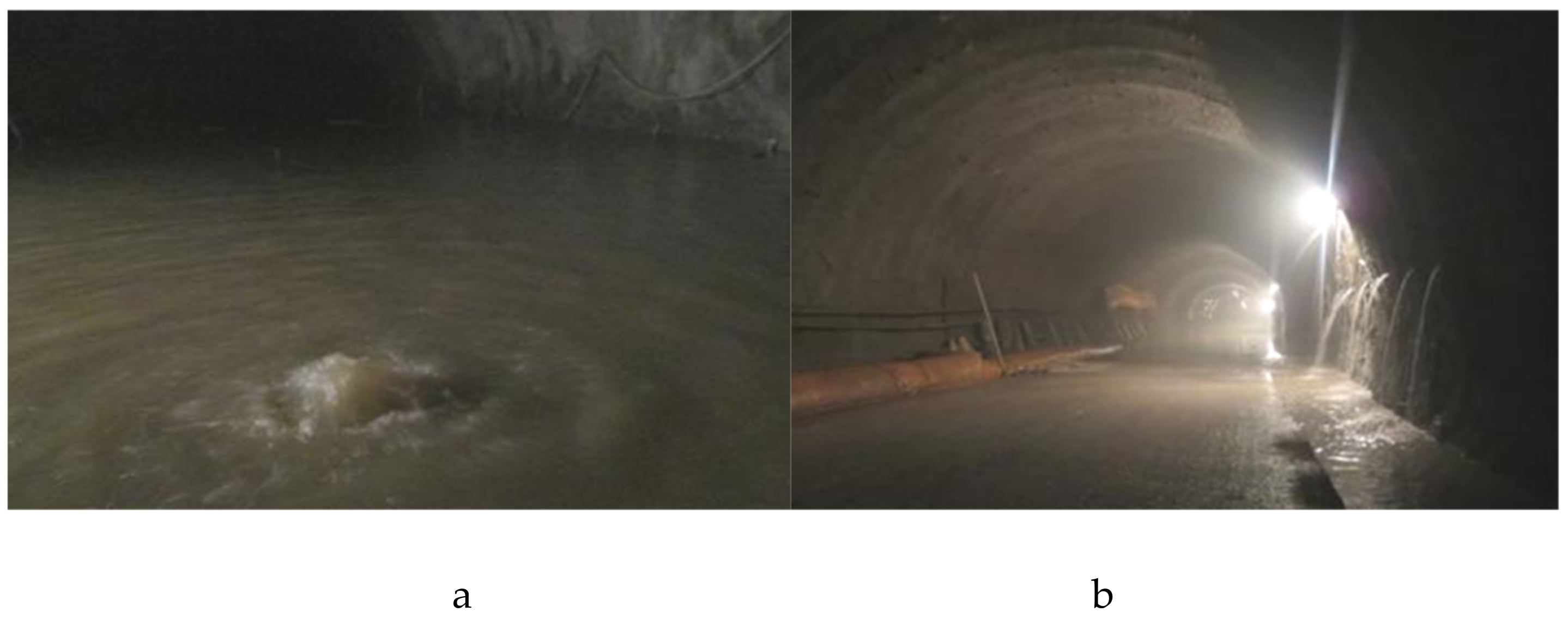


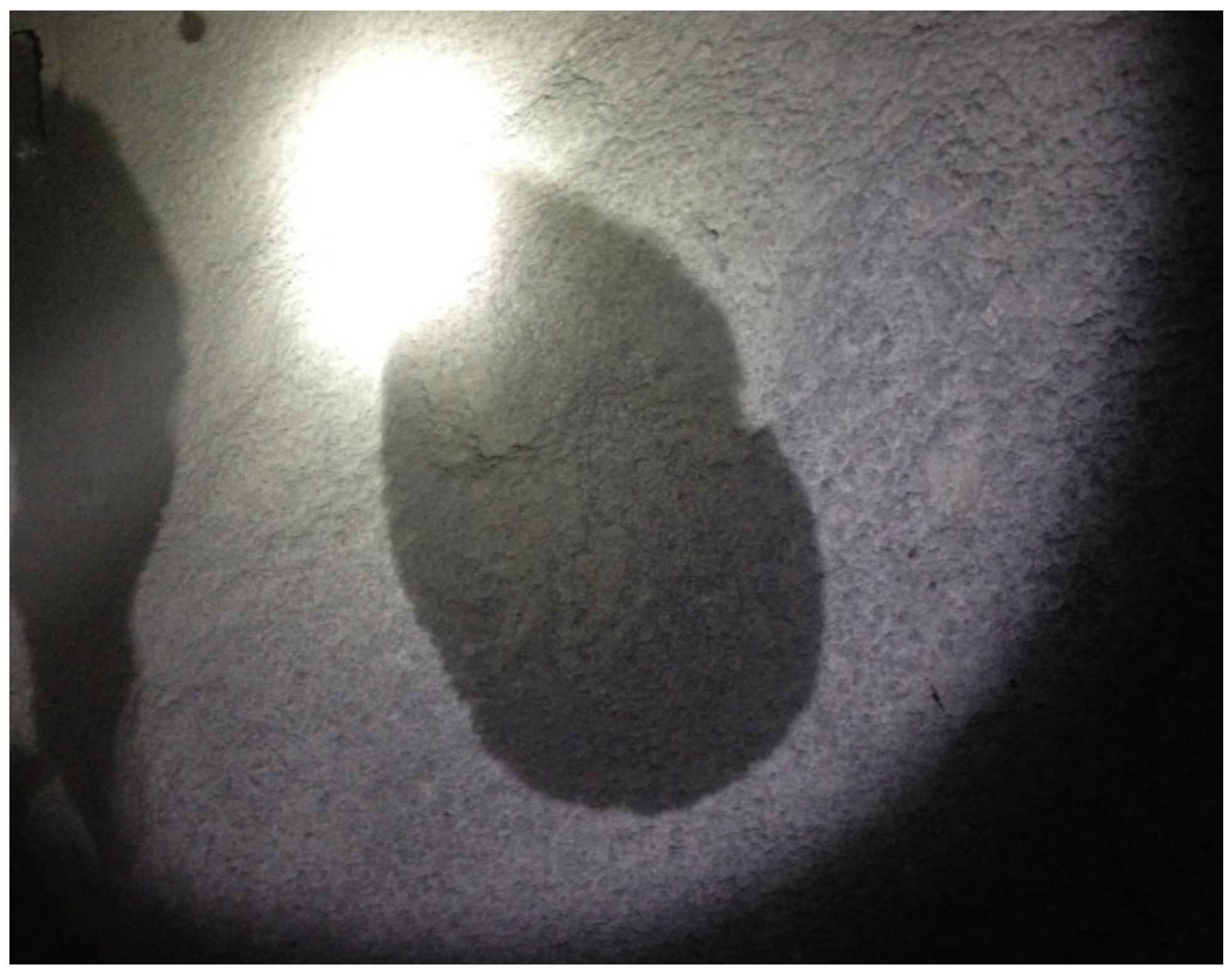
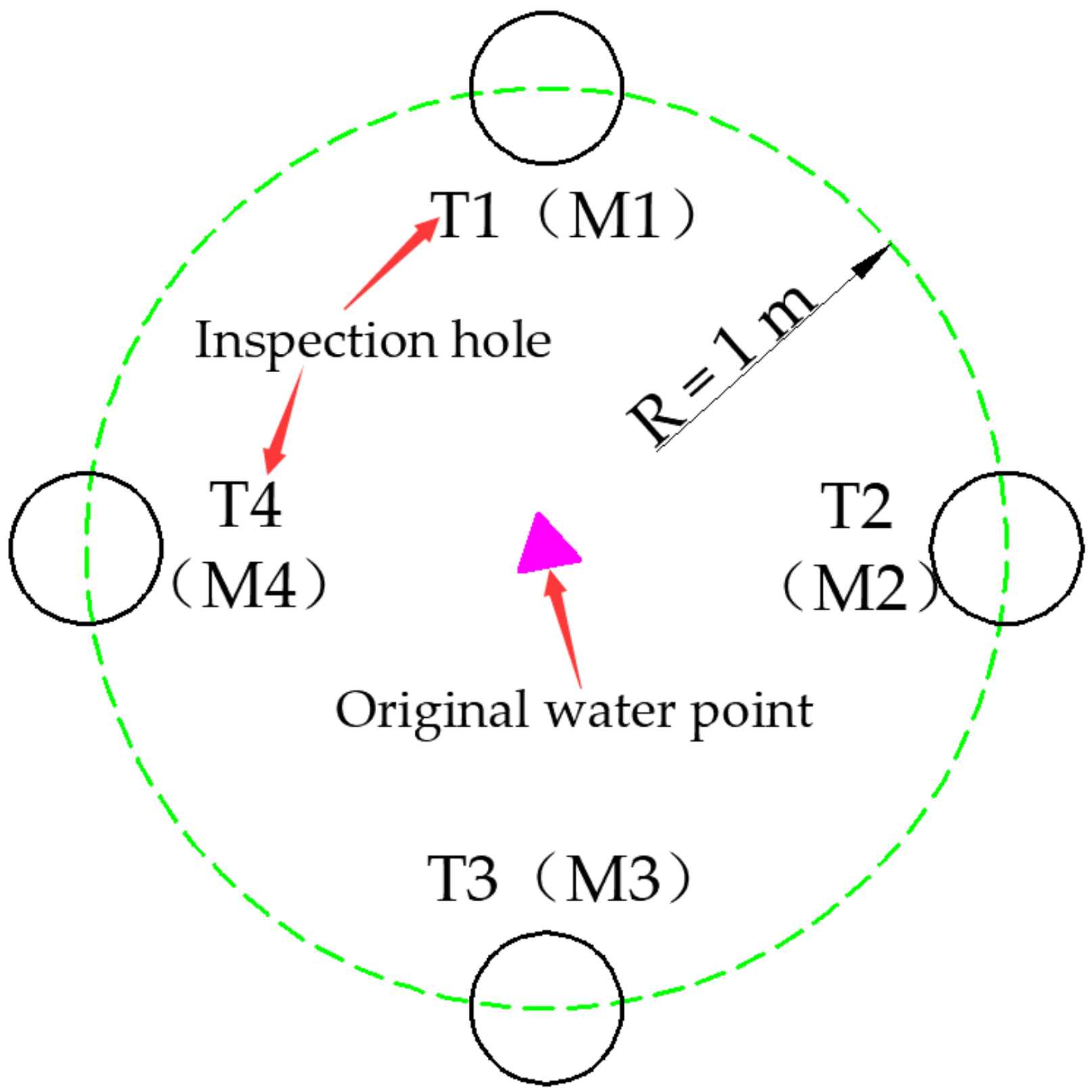
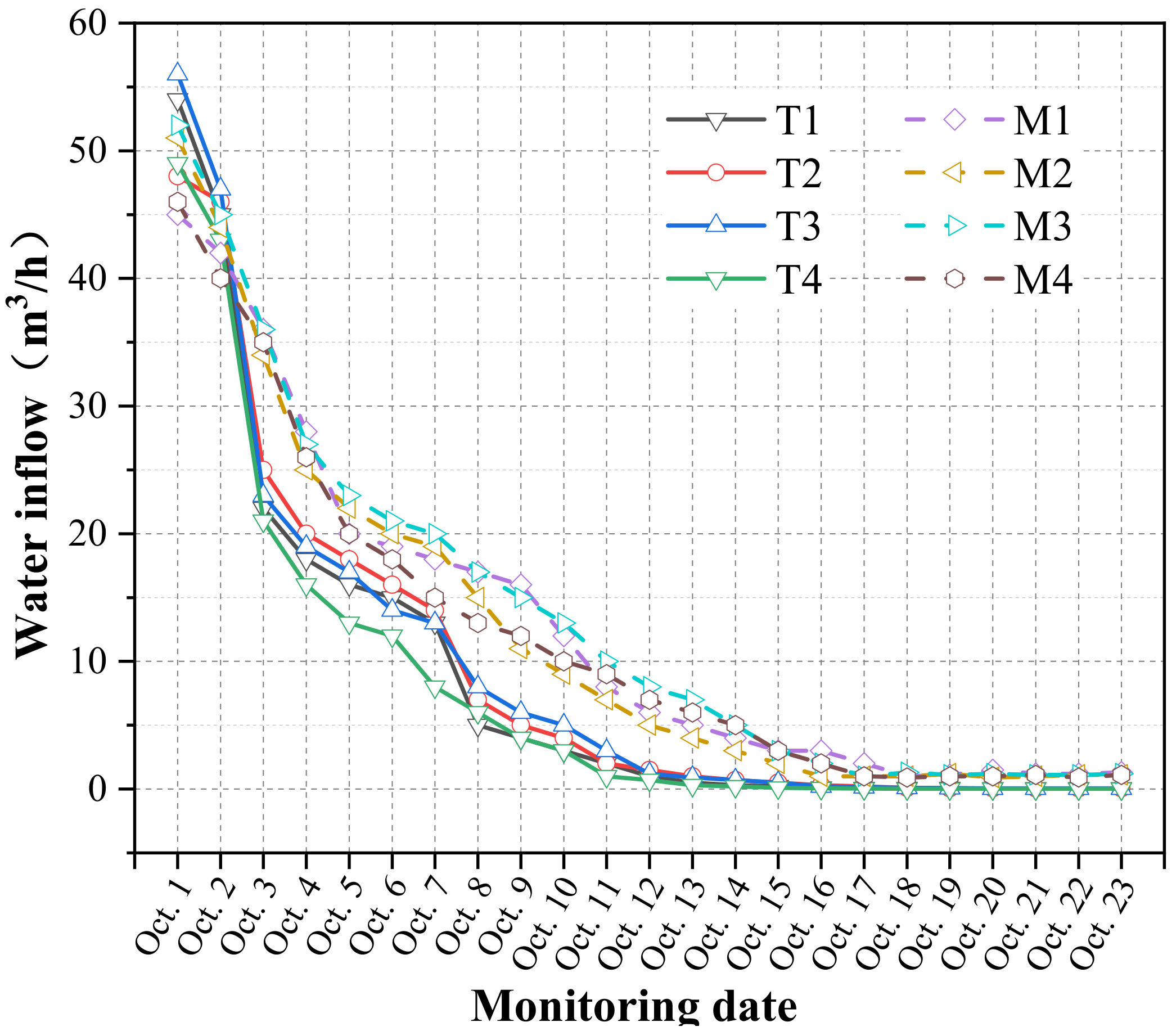
| Species | The Length (mm) | Equivalent Diameter (μm) | Fracture Strength (MPa) | Elongation at Break (%) | Modulus (GPa) | Melting Point (°C) |
|---|---|---|---|---|---|---|
| Cem-FIL 60 | 12 | 14 | 1700 | 3.6 | 72 | 1580 |
| HD | 12 | 14 | 1700 | 3.6 | 72 | 1580 |
| Name | Model | Precision Value for | Use | Appended Figures |
|---|---|---|---|---|
| Electro-hydraulic pressure testing machine | TYA-2000 | ±1% | CS test | Figure 2b |
| Flexural and Compressive tester | SYE-300 | ±1% | TS test | Figure 2c,d |
| FS test | ||||
| Program-controlled automatic pressure regulating impermeable instrument | HP-4.0 | 0.3% FS | IP test | Figure 2e |
| Project | Curing Time | ARGF Mixing Amount (volume %) | ||||||
|---|---|---|---|---|---|---|---|---|
| NCH-0 | CFIL-0.25 | CFIL-0.5 | CFIL-1.0 | HD-0.25 | HD-0.5 | HD-1.0 | ||
| 0 | 0.25 | 0.5 | 1.0 | 0.25 | 0.5 | 1.0 | ||
| CS | 3 d | A B C | A B C | A B C | A B C | A B C | A B C | A B C |
| 7 d | A B C | A B C | A B C | A B C | A B C | A B C | A B C | |
| 15 d | A B C | A B C | A B C | A B C | A B C | A B C | A B C | |
| 28 d | A B C | A B C | A B C | A B C | A B C | A B C | A B C | |
| TS | 3 d | A B C | A B C | A B C | A B C | A B C | A B C | A B C |
| 7 d | A B C | A B C | A B C | A B C | A B C | A B C | A B C | |
| 15 d | A B C | A B C | A B C | A B C | A B C | A B C | A B C | |
| 28 d | A B C | A B C | A B C | A B C | A B C | A B C | A B C | |
| FS | 3 d | A B C | A B C | A B C | A B C | A B C | A B C | A B C |
| 7 d | A B C | A B C | A B C | A B C | A B C | A B C | A B C | |
| 15 d | A B C | A B C | A B C | A B C | A B C | A B C | A B C | |
| 28 d | A B C | A B C | A B C | A B C | A B C | A B C | A B C | |
| IP | 3 d | A B C D E F | A B C D E F | A B C D E F | A B C D E F | A B C D E F | A B C D E F | A B C D E F |
| 7 d | A B C D E F | A B C D E F | A B C D E F | A B C D E F | A B C D E F | A B C D E F | A B C D E F | |
| 15 d | A B C D E F | A B C D E F | A B C D E F | A B C D E F | A B C D E F | A B C D E F | A B C D E F | |
| 28 d | A B C D E F | A B C D E F | A B C D E F | A B C D E F | A B C D E F | A B C D E F | A B C D E F | |
© 2020 by the authors. Licensee MDPI, Basel, Switzerland. This article is an open access article distributed under the terms and conditions of the Creative Commons Attribution (CC BY) license (http://creativecommons.org/licenses/by/4.0/).
Share and Cite
Shi, Z.; Wang, Q.; Xu, L. Experimental Study of Cement Alkali-Resistant Glass Fiber (C-ARGF) Grouting Material. Materials 2020, 13, 605. https://doi.org/10.3390/ma13030605
Shi Z, Wang Q, Xu L. Experimental Study of Cement Alkali-Resistant Glass Fiber (C-ARGF) Grouting Material. Materials. 2020; 13(3):605. https://doi.org/10.3390/ma13030605
Chicago/Turabian StyleShi, Zhenyue, Qingbiao Wang, and Lei Xu. 2020. "Experimental Study of Cement Alkali-Resistant Glass Fiber (C-ARGF) Grouting Material" Materials 13, no. 3: 605. https://doi.org/10.3390/ma13030605
APA StyleShi, Z., Wang, Q., & Xu, L. (2020). Experimental Study of Cement Alkali-Resistant Glass Fiber (C-ARGF) Grouting Material. Materials, 13(3), 605. https://doi.org/10.3390/ma13030605







